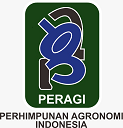POTENSI BAHAN PANGAN TEPUNG BIJI DURIAN SETELAH MELALUI MASA PENYIMPANAN
Abstract
Biji durian merupakan limbah selain kulit dari buah durian. Pemanfaatan biji durian sudah mulai banyak dilakukan baik berupa tepung ataupun hingga olahan makanan namun penelitian terhadap daya simpan dan kandungan dari tepung biji tersebut belum dilakukan. Penelitian ini dilakukan dengan melakukan penepungan, penyimpanan, dan kemudian pegujian terhadap tepung biji durian tersebut. Dari hasil pengujian diketahui bahwa kandungan tepung biji durian setelah dilakukan penyimpanan selama delapan bulan yaitu alkaloid yang tinggi, rendah kandungan terpenoid, kadar serat yang lebih tinggi dari tepung gandum, kadar air dan karbohidrat yang tinggi.
Keywords
Full Text:
PDFReferences
Amid, B. T., & Mirhosseini, H. (2012a). Erratum: Optimisation of aqueous extraction of gum from durian (Durio zibethinus) seed: A potential, low cost source of hydrocolloid (Food Chemistry (2012) 132 (1258-1268) DOI:10.1016/j.foodchem.2011.11.099). Food Chemistry, 134(3), 1591. https://doi.org/10.1016/j.foodchem.2012.03.125
Amid, B. T., & Mirhosseini, H. (2012b). Influence of different purification and drying methods on rheological properties and viscoelastic behaviour of durian seed gum. Carbohydrate Polymers, 90(1), 452–461.
https://doi.org/10.1016/j.carbpol.2012.05.065
BPS. (2019). Provinsi Kalimantan Barat dalam Angka. http://library1.nida.ac.th/termpaper6/sd/2554/19755.pdf
Bronikowska, J., Szliszka, E., Jaworska, D., Czuba, Z. P., & Krol, W. (2012). The coumarin psoralidin enhances anticancer effect of tumor necrosis factor-related apoptosis-inducing ligand (TRAIL). Molecules, 17(6), 6449–6464. https://doi.org/10.3390/molecules17066465
Cornelia, M., Siratantri, T., & Prawita, R. (2015). The Utilization of Extract Durian (Durio zibethinus L.) Seed Gum as an Emulsifier in Vegan Mayonnaise. Procedia Food Science, 3, 1–18. https://doi.org/10.1016/j.profoo.2015.01.001
Cornelia, M., Syarief, R., Effendi, H., & Nurtama, B. (2013). Pemanfaatan Pati Biji Durian (Durio zibethinus Murr.) dan Pati Sagu (Metroxylon sp.) Dalam Pembuatan Bioplastik. Jurnal Kimia Dan Kemasan, 35(1), 20. https://doi.org/10.24817/jkk.v35i1.1869
Dang, T.-N., & Nguyen, B. H. (2015). Study on Durian Processing Technology and Defleshing Machine. Asia Pacific Journal of Sustainable Agriculture, Food and Energy, 3(1), 12–16. http://journal.bakrie.ac.id/index.php/APJSAFE
Feng, J., Wang, Y., Yi, X., Yang, W., & He, X. (2016). Phenolics from durian exert pronounced NO inhibitory and antioxidant activities. Journal of Agricultural and Food Chemistry, 64(21), 4273–4279. https://doi.org/10.1021/acs.jafc.6b01580
Foo, K. Y., & Hameed, B. H. (2011). Transformation of durian biomass into a highly valuable end commodity: Trends and opportunities. Biomass and Bioenergy, 35(7), 2470–2478. https://doi.org/10.1016/j.biombioe.2011.04.004
Ghazali, K. A., Salleh, S. F., Riayatsyah, T. M. I., Aditiya, H. B., & Mahlia, T. M. I. (2016). The effect of dilute acid pre-treatment process in bioethanol production from durian (Durio zibethinus) seeds waste. IOP Conference Series: Earth and Environmental Science, 32(1). https://doi.org/10.1088/1755-1315/32/1/012058
Ho, L. H., & Bhat, R. (2015). Exploring the potential nutraceutical values of durian (Durio zibethinus L.) - An exotic tropical fruit. Food Chemistry, 168, 80–89. https://doi.org/10.1016/j.foodchem.2014.07.020
Liu, Y., Feng, S., Song, L., He, G., Chen, M., & Huang, D. (2013). Secondary metabolites in durian seeds: Oligomeric proanthocyanidins. Molecules, 18(11), 14172–14185. https://doi.org/10.3390/molecules181114172
Mirhosseini, H., Abdul Rashid, N. F., Tabatabaee Amid, B., Cheong, K. W., Kazemi, M., & Zulkurnain, M. (2015). Effect of partial replacement of corn flour with durian seed flour and pumpkin flour on cooking yield, texture properties, and sensory attributes of gluten free pasta. LWT - Food Science and Technology, 63(1), 184–190. https://doi.org/10.1016/j.lwt.2015.03.078
Rudiyansyah, Lambert, L. K., & Garson, M. J. (2010). Lignans and triterpenes from the bark of Durio carinatus and Durio oxleyanus. Journal of Natural Products, 73(10), 1649–1654. https://doi.org/10.1021/np100332v
Senu, Z. M., Husin, M., & Li, A. R. (2015). Icgsce 2014. Icgsce 2014, 123–130. https://doi.org/10.1007/978-981-287-505-1
Srianta, I., Hendrawan, B., Kusumawati, N., & Blanc, P. J. (2012). Study on durian seed as a new substrate for Angkak production. International Food Research Journal, 19(3), 941–945.
Amid, B. T., & Mirhosseini, H. (2012a). Erratum: Optimisation of aqueous extraction of gum from durian (Durio zibethinus) seed: A potential, low cost source of hydrocolloid (Food Chemistry (2012) 132 (1258-1268) DOI:10.1016/j.foodchem.2011.11.099). Food Chemistry, 134(3), 1591. https://doi.org/10.1016/j.foodchem.2012.03.125
Amid, B. T., & Mirhosseini, H. (2012b). Influence of different purification and drying methods on rheological properties and viscoelastic behaviour of durian seed gum. Carbohydrate Polymers, 90(1), 452–461.
https://doi.org/10.1016/j.carbpol.2012.05.065
BPS. (2019). Provinsi Kalimantan Barat dalam Angka. http://library1.nida.ac.th/termpaper6/sd/2554/19755.pdf
Bronikowska, J., Szliszka, E., Jaworska, D., Czuba, Z. P., & Krol, W. (2012). The coumarin psoralidin enhances anticancer effect of tumor necrosis factor-related apoptosis-inducing ligand (TRAIL). Molecules, 17(6), 6449–6464. https://doi.org/10.3390/molecules17066465
Cornelia, M., Siratantri, T., & Prawita, R. (2015). The Utilization of Extract Durian (Durio zibethinus L.) Seed Gum as an Emulsifier in Vegan Mayonnaise. Procedia Food Science, 3, 1–18. https://doi.org/10.1016/j.profoo.2015.01.001
Cornelia, M., Syarief, R., Effendi, H., & Nurtama, B. (2013). Pemanfaatan Pati Biji Durian (Durio zibethinus Murr.) dan Pati Sagu (Metroxylon sp.) Dalam Pembuatan Bioplastik. Jurnal Kimia Dan Kemasan, 35(1), 20. https://doi.org/10.24817/jkk.v35i1.1869
Dang, T.-N., & Nguyen, B. H. (2015). Study on Durian Processing Technology and Defleshing Machine. Asia Pacific Journal of Sustainable Agriculture, Food and Energy, 3(1), 12–16. http://journal.bakrie.ac.id/index.php/APJSAFE
Feng, J., Wang, Y., Yi, X., Yang, W., & He, X. (2016). Phenolics from durian exert pronounced NO inhibitory and antioxidant activities. Journal of Agricultural and Food Chemistry, 64(21), 4273–4279. https://doi.org/10.1021/acs.jafc.6b01580
Foo, K. Y., & Hameed, B. H. (2011). Transformation of durian biomass into a highly valuable end commodity: Trends and opportunities. Biomass and Bioenergy, 35(7), 2470–2478. https://doi.org/10.1016/j.biombioe.2011.04.004
Ghazali, K. A., Salleh, S. F., Riayatsyah, T. M. I., Aditiya, H. B., & Mahlia, T. M. I. (2016). The effect of dilute acid pre-treatment process in bioethanol production from durian (Durio zibethinus) seeds waste. IOP Conference Series: Earth and Environmental Science, 32(1). https://doi.org/10.1088/1755-1315/32/1/012058
Ho, L. H., & Bhat, R. (2015). Exploring the potential nutraceutical values of durian (Durio zibethinus L.) - An exotic tropical fruit. Food Chemistry, 168, 80–89. https://doi.org/10.1016/j.foodchem.2014.07.020
Liu, Y., Feng, S., Song, L., He, G., Chen, M., & Huang, D. (2013). Secondary metabolites in durian seeds: Oligomeric proanthocyanidins. Molecules, 18(11), 14172–14185. https://doi.org/10.3390/molecules181114172
Mirhosseini, H., Abdul Rashid, N. F., Tabatabaee Amid, B., Cheong, K. W., Kazemi, M., & Zulkurnain, M. (2015). Effect of partial replacement of corn flour with durian seed flour and pumpkin flour on cooking yield, texture properties, and sensory attributes of gluten free pasta. LWT - Food Science and Technology, 63(1), 184–190. https://doi.org/10.1016/j.lwt.2015.03.078
Rudiyansyah, Lambert, L. K., & Garson, M. J. (2010). Lignans and triterpenes from the bark of Durio carinatus and Durio oxleyanus. Journal of Natural Products, 73(10), 1649–1654. https://doi.org/10.1021/np100332v
Senu, Z. M., Husin, M., & Li, A. R. (2015). Icgsce 2014. Icgsce 2014, 123–130. https://doi.org/10.1007/978-981-287-505-1
Srianta, I., Hendrawan, B., Kusumawati, N., & Blanc, P. J. (2012). Study on durian seed as a new substrate for Angkak production. International Food Research Journal, 19(3), 941–945.
Refbacks
- There are currently no refbacks.



























